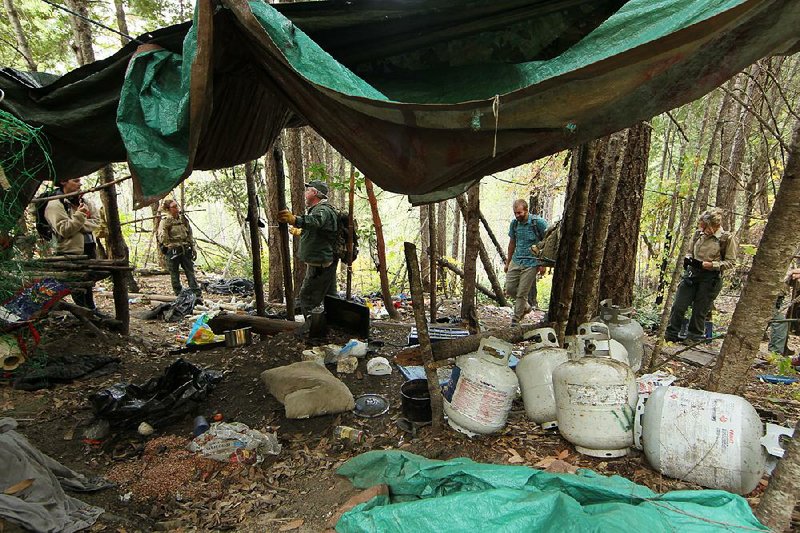LOS ANGELES -- Two months after two men were arrested at an illicit marijuana farm on public land deep in the Northern California wilderness, authorities are assessing the environmental impact and cleanup costs at the site where trees were clear-cut, waterways were diverted, and the ground was littered with open containers of fertilizer and rodenticide.
A group including U.S. Forest Service rangers, local law enforcement officers, scientists and conservationists hiked into the so-called trespass grow where nearly 9,000 cannabis plants were illegally cultivated. The site was on national forestland in a region known as the Emerald Triangle because of the marijuana that has been produced there for decades.
Authorities say members of an international drug-trafficking ring set up camp at the site as far back as 2015.
When deputies raided the remote clearing in the woods on Sept. 9, they found hundreds of pounds of harvested marijuana, thousands of pounds of trash and more than 3 miles of plastic irrigation piping, according to the Trinity County sheriff's office. They also discovered bottles of carbofuran, a banned neurotoxicant used to kill rodents that also has been linked to the deaths of spotted owls, fish and mountain lions. A quarter-teaspoon can kill a 300-pound bear.
The case highlights some of the growing pains California has faced since kicking off broad legal sales of marijuana in 2018. Its legal marijuana market has grown to more than $3 billion but is still dwarfed by a thriving illegal market, which is estimated to rake in nearly $9 billion annually. Limited resources mean officials can't keep up with all the illegal sites that are remnants of the outlaw era, when much of the marijuana for the U.S. black market hailed from the Emerald Triangle.
Experts say illegal sites like the one found in the Shasta-Trinity National Forest, about 100 miles from the Oregon border, siphon valuable water, pollute legal downstream grows and funnel potentially tainted cannabis onto the streets.
"These places are toxic garbage dumps. Food containers attract wildlife, and the chemicals kill the animals long after the sites are abandoned," said Rich McIntyre, director of the Cannabis Removal on Public Lands Project, which is dedicated to restoring criminal grow sites on state and federal property in California. "We think there's a public-health time bomb ticking."
The group is a coalition of conservation organizations, tribes, elected officials, law enforcement agencies and federal land managers. Also lending its support is the legal cannabis industry, which says it's being undercut by the criminal market. Officials estimate that up to 70% of California's illicit pot comes from trespass grows, mostly on public land.
"We see illegal grows as undermining the legal cultivators and manufacturers" by reducing tax revenue, said Lindsay Robinson, executive director of the California Cannabis Industry Association, a trade group. "We're seeing untested and unregulated cannabis flooding the market."
Black-market marijuana is potentially dangerous because traces of the toxic chemicals used at grow sites are often found in the plants, she said.
"If you have an illicit grow upstream from you, and you're legal, that could end up tainting your product and prevent it from entering the market," Robinson said.
The Cannabis Removal on Public Lands Project estimates that 9 billion gallons of water are diverted to trespass grows in California each year -- a yearly supply for a city of 35,000 homes.
"In a state like California where water battles and drought are a way of life, that number is shocking," McIntyre said. More than 60% of California's water comes from national forestland.
Authorities in 2018 made dozens of arrests at trespass grows while seizing hundreds of thousands of marijuana plants along with cash and guns. Criminal growers often use powerful firearms to protect their operations, McIntyre said.
"There are stories of people -- hunters, fishermen, hikers -- who find themselves down the barrel of an AK-47" after stumbling on illegal grow sites, he said.
The toxic chemicals were cleared from the Shasta site Oct. 16, and a "decommissioning" cleanup -- removing everything taken there by growers -- should happen within a year, officials say. The goal is to restore illegal grow sites to pristine condition complete with reseeding and replanting, but that plan lacks funding.
The Cannabis Removal on Public Lands Project is lobbying for federal and state money to clean and reclaim an estimated 2,000 sites, a process it says could take seven to 10 years.
It's also pushing to increase the number of U.S. Forest Service rangers in California's national forests. Reclaiming each site costs an average of $40,000, requiring trained crews, law enforcement resources and often National Guard air support to remove tons of materials from remote areas, the group said.
A Section on 11/18/2019
